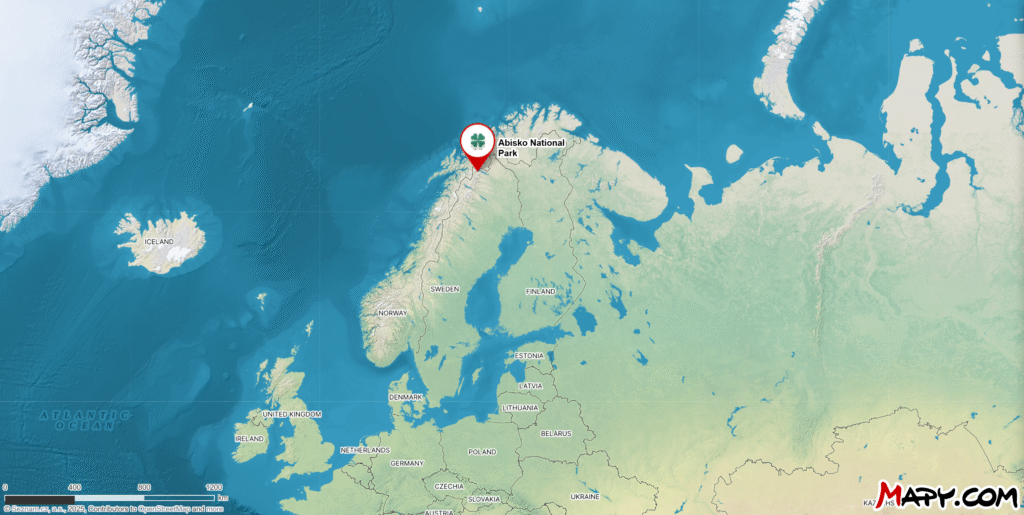This entry is part 2 of 2 in the series Blue Holes Theme Week

The Blue Hole of Abisko
We learned that blue holes are nexuses of past and present, a mixing of geological processes related to land and sea.
These sinkholes produce stunning features, including the Great Blue Hole of Belize.
But there’s another type of blue hole, too, one that brings skies into the party.
In Sweden, the village of Abisko makes a strong claim thanks to its namesake blue hole: the best place on Earth to view the northern lights.


Located about 20 miles east of the Ofotfjord, a finger of the larger inlet of the Norwegian Sea, the Vestfjorden, Abisko sits within an eponymous National Park. The village nestles next to a lake called Torneträsk.
This area would be gorgeous without light shows in the night sky. The region bears the telltale signs of one of Earth’s master sculptors: glaciation. The fjords, the mountains, and the lake were all whittled by ice during the last glacial maximum.



Abisko is about 125 miles (200 kilometers) north of the Arctic Circle, which grants the region a period of endless summer daylight each year. Its location also puts the village into another special zone, called the auroral oval.
For many parts of the globe, the northern and southern lights are a rarity that requires an exceptional solar event. In the auroral oval, however, aurorae are far more common, potentially ever-present. During perpetual sunlight, you might be unable to see the aurora, but the activity necessary for its presentation is still happening.
Abisko rests right on the edge of the oval, making it a fantastic spot to see the northern lights.

As millions of people learned during the Great North American Eclipse in 2024, sometimes you have to be lucky to see nature’s fireworks. If Mother Nature decides you’re in for clouds during an eclipse or an auroral outbreak, you’re not going to be happy.
Perhaps cruelly, Abisko’s proximity to the sea means the general region experiences a large number of cloudy days. The jet stream brings constant wind from the west, meaning moisture from the ocean slams into the coast.
At Ofotfjord, the northern lights might dance above your head most days of the year, yet you might easily not know it, thanks to cloud cover.
Yet, we opened this article by touting Abisko as one of the world’s premier spots to see the aurora. How can both these realities coexist?
Enter the Blue Hole of Abisko!

The Scandinavian Mountains run the breadth of the peninsula, more than 1,100 miles (1,700 kilometers).
In many places, they nearly slam into the Norwegian Sea.
Mountains can have an incredible impact on local climates. A series of chains saps all the water from the Pacific Ocean on its way to Death Valley, creating the hottest place on the planet. Quite often, when weather systems move over chains, the water tends to dump on one side of the mountains, creating a so-called rain shadow on the other.
Between the wet winds of the jet stream and Abisko, the Scandinavian mountains force air to rise, forming rain clouds. The western side of the range gets wet. When the air moves over the peaks, it is drier and descends. Combining this fact with the stabilizing temperatures of the large lake nearby, something incredible develops.
A blue hole!
This phenomenon is so stable that Abisko features what meteorologists call a microclimate. All around the village, clouds dominate, but thanks to its special geographical ingredients, Abisko often lies supine under royal blue sky.

A spot inside the auroral oval, clear skies, and remoteness leading to little light pollution is a recipe that allows Abisko to bill itself as the best place on Earth to view the northern lights.
Tourists from around the world now flock to Abisko to view the spectacle. The blue hole is so stable that people can visit the village to see the lights with near certainty, even if the rest of the region’s forecast is poor.
This attribute almost seems like a magical Earth hack.



Intriguingly, the blue hole leads to another dazzling draw for Abisko, this one related to daylight.
The lack of clouds directly above the area with simultaneous access to nearby rainclouds provides all the necessary parts for vibrant rainbows!
During the day, Abisko tosses out abundant chromatic arcs.



On its own, the Blue Hole of Abisko might not contain as much aqueous beauty as something like the Great Blue Hole of Belize, but it opens a metaphorical door to displays in the firmament just as captivating.
To emend a cliche, most places – including those surrounding Abisko – might not be all rainbows and aurorae, but in this northern Swedish spot with a microclimate, it really is quite literally all rainbows and northern lights.
Further Reading and Exploration
A ‘blue hole’ to the Northern Lights – BBC
What is the “blue hole” of Abisko and why does it make Abisko National Park the best place on Earth to see the northern lights? – Lights Over Lapland
I put Abisko’s ‘cloud-busting weapon’ to the test during a Sweden northern lights adventure and was not disappointed – Space













